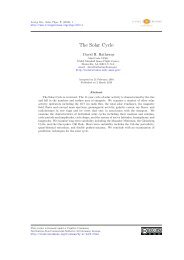PDF (for b&w printout) - Living Reviews in Solar Physics
PDF (for b&w printout) - Living Reviews in Solar Physics
PDF (for b&w printout) - Living Reviews in Solar Physics
Create successful ePaper yourself
Turn your PDF publications into a flip-book with our unique Google optimized e-Paper software.
The Sun <strong>in</strong> Time: Activity and Environment 27<br />
<strong>in</strong> particular <strong>for</strong> stars with small <strong>in</strong>cl<strong>in</strong>ation angles. This model is preferred because correlations<br />
<strong>in</strong>volv<strong>in</strong>g the fractional variation <strong>in</strong> the rotation period show the same behavior <strong>for</strong> the two subclasses.<br />
Support <strong>for</strong> the model comes from simulations of magnetic-field migration toward the<br />
poles <strong>in</strong> very active stars, as per<strong>for</strong>med by Schrijver and Title (2001) (Section 4.1.2). Specifically,<br />
Mess<strong>in</strong>a and Gu<strong>in</strong>an (2003) have found a power-law relation between the rotation-period variation,<br />
∆P , and the average rotation period, P , of the <strong>for</strong>m (see Figure 9a)<br />
∆P ∝ P 1.42±0.5 . (2)<br />
Further, a tight correlation is found between differential rotation, parameterized by ∆Ω/Ω, and<br />
the activity cycle frequency, ωcycl,<br />
ωcycl ∝ e (−0.055±0.004)∆Ω/Ω , (3)<br />
suggest<strong>in</strong>g that ∆Ω/Ω is a key parameter controll<strong>in</strong>g the duration of the activity cycle (see<br />
Figure 9b).<br />
Differential rotation has also been measured on other very active stars (e.g., Donati et al.<br />
2003a), among them a solar-like post-T Tauri star (Donati et al., 2000), <strong>in</strong> particular based on<br />
Doppler imag<strong>in</strong>g techniques (Section 4.1.1). Differential rotation was found to be solar-like <strong>in</strong> these<br />
examples, although time-variable, which may h<strong>in</strong>t at dynamo processes that periodically convert<br />
magnetic <strong>in</strong>to k<strong>in</strong>etic energy and vice versa (Donati et al., 2003a).<br />
Figure 9: Left (a): Rotation period variation as a function of the mean rotation period, <strong>for</strong> a sample<br />
of young solar analogs. The solid l<strong>in</strong>e is a power-law fit to the entire sample also conta<strong>in</strong><strong>in</strong>g early<br />
K stars, while the dotted l<strong>in</strong>e is a fit to the G-star sample only. Key to the labels: A = BE Cet, B<br />
= κ 1 Cet, C = π 1 UMa, D = EK Dra, E = HN Peg, F = DX Leo (K0 V), G = AB Dor (K0 V),<br />
H = LQ Hya (K2 V), I = 107 Psc (K1 V), L = 61 UMa (G8 V), M = β Com, N = HD 160346<br />
(K3 V), O = 15 Sge, S = Sun (from Mess<strong>in</strong>a and Gu<strong>in</strong>an, 2003). Right (b): The activity cycle<br />
frequency is shown as a function of the relative surface differential rotation amplitude, ∆Ω/Ω.<br />
Vertical dotted l<strong>in</strong>es connect multiple cycles. Three different branches are <strong>in</strong>dicated by the solid<br />
curves (from Mess<strong>in</strong>a and Gu<strong>in</strong>an, 2003, repr<strong>in</strong>ted with permission).<br />
4.3.2 X-ray cycles of solar analogs<br />
Given the much stronger variability <strong>in</strong> the outer, coronal layers of a stellar atmosphere, an activity<br />
cycle may be more easily identified <strong>in</strong> the X-ray or radio doma<strong>in</strong>s. However, such cycles have eluded<br />
<strong>Liv<strong>in</strong>g</strong> <strong>Reviews</strong> <strong>in</strong> <strong>Solar</strong> <strong>Physics</strong><br />
http://www.liv<strong>in</strong>greviews.org/lrsp-2007-3



